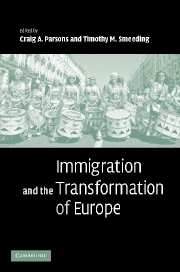Book contents
- Frontmatter
- Contents
- List of figures
- List of tables
- List of contributors
- Acknowledgements
- 1 What's unique about immigration in Europe?
- 2 Europe's immigration challenge in demographic perspective
- 3 Migration into OECD countries 1990–2000
- 4 Divergent patterns in immigrant earnings across European destinations
- 5 Economic consequences of immigration in Europe
- 6 Occupational status of immigrants in cross-national perspective: A multilevel analysis of seventeen Western societies
- 7 Immigrants, unemployment, and Europe's varying welfare regimes
- 8 How different are immigrants? A cross-country and cross-survey analysis of educational achievement
- 9 Immigration, education, and the Turkish second generation in five European nations: A comparative study
- 10 Managing transnational Islam: Muslims and the state in Western Europe
- 11 Migration mobility in European diasporic space
- 12 The new migratory Europe: Towards a proactive immigration policy?
- 13 European immigration in the people's court
- 14 The politics of immigration in France, Britain, and the United States: A transatlantic comparison
- 15 “Useful” Gastarbeiter, burdensome asylum seekers, and the second wave of welfare retrenchment: Exploring the nexus between migration and the welfare state
- 16 The European Union dimension: Supranational integration, free movement of persons, and immigration politics
- 17 The effectiveness of governments’ attempts to control unwanted migration
- Index
- References
1 - What's unique about immigration in Europe?
Published online by Cambridge University Press: 23 June 2009
- Frontmatter
- Contents
- List of figures
- List of tables
- List of contributors
- Acknowledgements
- 1 What's unique about immigration in Europe?
- 2 Europe's immigration challenge in demographic perspective
- 3 Migration into OECD countries 1990–2000
- 4 Divergent patterns in immigrant earnings across European destinations
- 5 Economic consequences of immigration in Europe
- 6 Occupational status of immigrants in cross-national perspective: A multilevel analysis of seventeen Western societies
- 7 Immigrants, unemployment, and Europe's varying welfare regimes
- 8 How different are immigrants? A cross-country and cross-survey analysis of educational achievement
- 9 Immigration, education, and the Turkish second generation in five European nations: A comparative study
- 10 Managing transnational Islam: Muslims and the state in Western Europe
- 11 Migration mobility in European diasporic space
- 12 The new migratory Europe: Towards a proactive immigration policy?
- 13 European immigration in the people's court
- 14 The politics of immigration in France, Britain, and the United States: A transatlantic comparison
- 15 “Useful” Gastarbeiter, burdensome asylum seekers, and the second wave of welfare retrenchment: Exploring the nexus between migration and the welfare state
- 16 The European Union dimension: Supranational integration, free movement of persons, and immigration politics
- 17 The effectiveness of governments’ attempts to control unwanted migration
- Index
- References
Summary
To begin
A new kind of historic transformation is underway in Europe at the outset of the twenty-first century. Twentieth-century Europeans were no strangers to social, economic, and political change, but their major challenges focused mainly on the intra-European construction of stable, prosperous, capitalist democracies. While the extra-European world obviously affected the continent in many ways, the biggest problems turned on compromises within or between European societies (and with the most influential offshoot of European society, the United States). In many ways, the creation of a single currency for the European Union in 1999 marked a fitting conclusion to Europe's inwardly-focused twentieth century. Today, by contrast, most Europeans perceive their main challenges as related to flows across their borders – flows of Europeans from other European Union nations (including the ten new partners from eastern and southern Europe), but particularly inflows of non-European people. Immigration and minority integration consistently occupy the headlines and loom over the political agenda, even playing some role in the French and Dutch rejections of the European Constitution in Spring 2005. Moreover, the issues that rival immigration for immediate political salience – unemployment, crime, terrorism – are often presented by politicians as its negative secondary effects. Immigration is also intimately tied to serious global economic pressures, the challenges of population ageing, and welfare-state reform. Both academic observers and the European public are increasingly convinced that Europe's future will turn to a substantial degree on how they incorporate and integrate non-Europeans into European culture, customs and institutions.
- Type
- Chapter
- Information
- Immigration and the Transformation of Europe , pp. 1 - 29Publisher: Cambridge University PressPrint publication year: 2006
References
- 6
- Cited by



